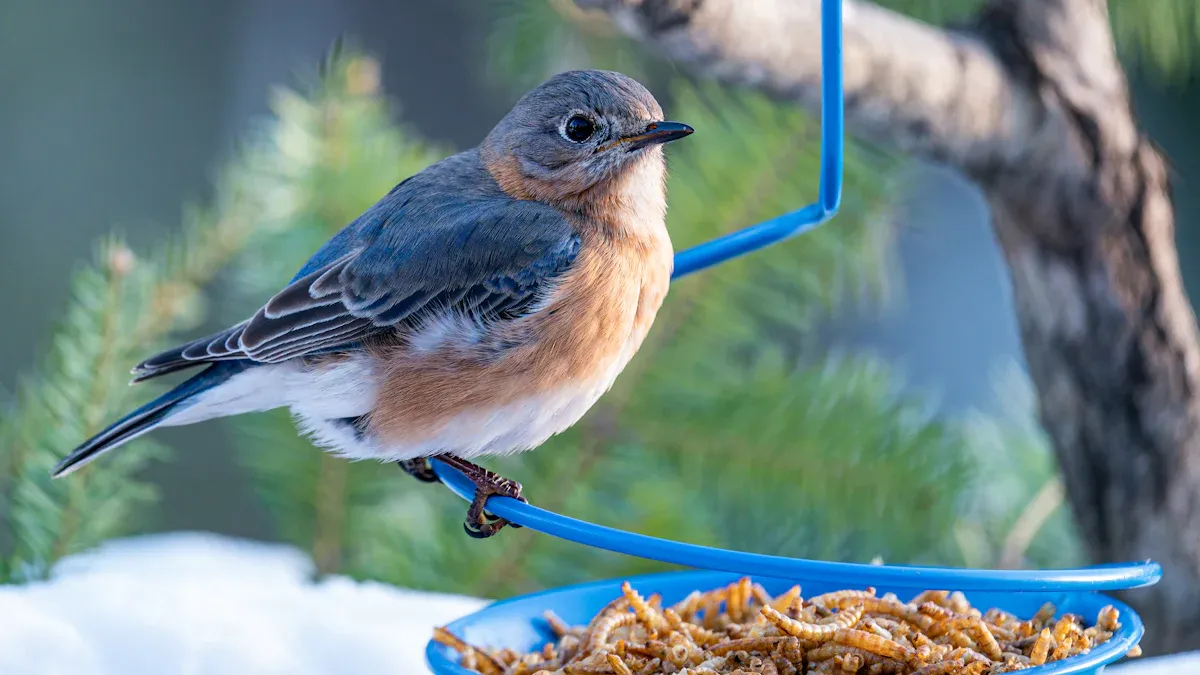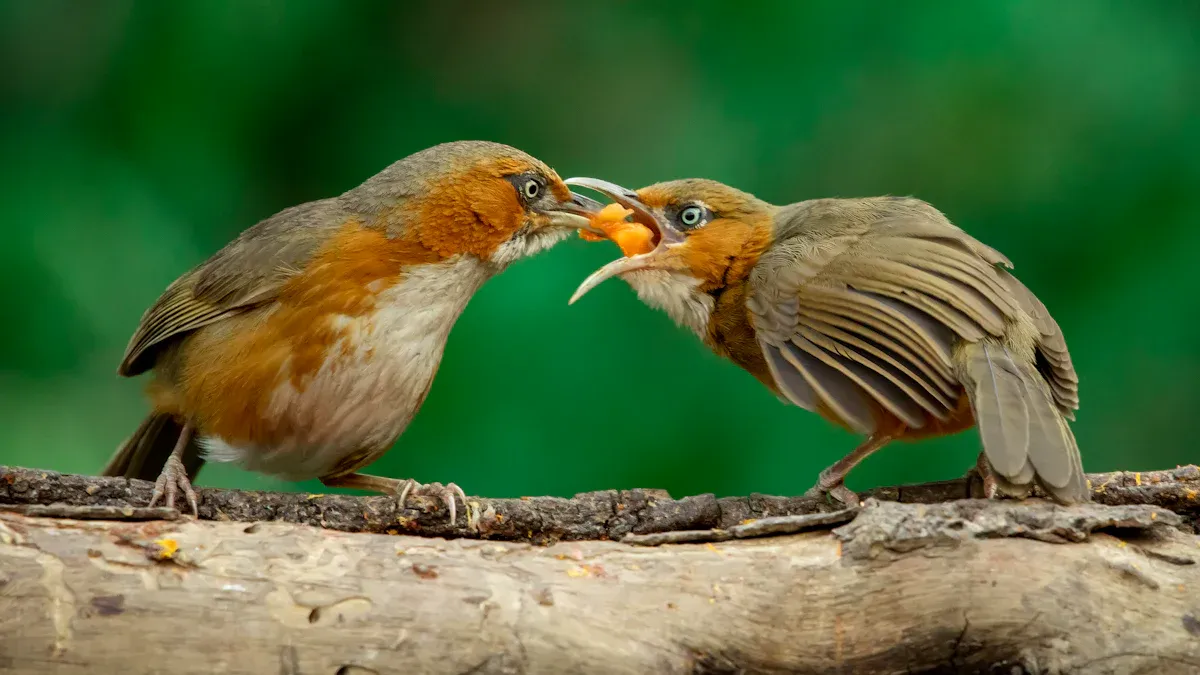
Wild birds need nutrient-rich food to thrive, especially during breeding, migration, and winter. Mealworms for wild birds provide an excellent source of protein, fat, and fiber, far surpassing the nutritional value of many natural diets. For example, dried mealworms contain 53% protein and 28% fat, making them a powerhouse food for energy and survival.
Mixing mealworms for wild birds with seeds or fruits can attract a variety of bird species, turning your backyard into a birdwatching haven.
Key Takeaways
- Mealworms são full of nutrients for wild birds. They give birds lots of protein and fat, helping them stay energized, especially in winter or breeding season.
- Mix mealworms with seeds or fruits to attract many bird species. This can make your backyard a fun place to watch birds.
- Pick the right mealworms and feeders to keep food fresh. Keep the feeding area clean to help birds stay healthy.
Which Birds Eat Mealworms for Wild Birds?

Common backyard birds that eat mealworms
Many backyard birds love mealworms for their high nutritional value. These birds are primarily insect-eaters and rely on protein-rich diets, especially during breeding seasons. Some of the most common backyard visitors that enjoy mealworms include:
- Bluebirds
- Robins
- Woodpeckers
- Chickadees
- Orioles
Offering mealworms for wild birds can attract these species to your feeders, creating a lively and diverse birdwatching experience.
Migratory and seasonal birds that benefit from mealworms
Mealworms play a vital role in helping migratory birds during their seasonal journeys. In winter, when natural food sources become scarce, mealworms provide essential nutrients that help birds survive harsh weather. During breeding seasons, they serve as a concentrated source of protein, which is crucial for muscle development and the health of nestlings. By offering mealworms, you can support these birds during their most challenging times.
Insect-eating bird species attracted by mealworms
Insect-eating birds are naturally drawn to mealworms due to their resemblance to the insects these birds consume in the wild. Here’s a quick look at one such species:
| Bird Species | Attraction to Mealworms | Nutritional Benefits |
|---|---|---|
| Bluebirds | High | Excellent source of nutrients, especially during cold weather and spring reproduction |
Mealworms serve as a healthy addition to the diet of insect-eating birds, complementing the native insects and plants they typically consume. While they may not provide as much calcium as other insects like caterpillars, mealworms still play a significant role in supporting bird health, especially in urban areas where natural insect populations are limited.
Nutritional Benefits of Mealworms for Wild Birds
Protein and fat for energy and survival
Mealworms are a fantastic source of energy for wild birds. Their high protein and fat content make them ideal for meeting birds’ energy needs, especially during colder months. Birds require extra fat to stay warm in winter and protein to maintain their feathers and muscles. Compared to other common bird foods, mealworms stand out.
| Tipo de alimento | Protein Content | Fat Content |
|---|---|---|
| Live Mealworms | 20% | 13% |
| Dried Mealworms | 53% | 28% |
This nutritional profile makes mealworms a reliable food source for survival and energy, particularly when natural food is scarce.
Essential nutrients for breeding and raising young
Mealworms provide essential nutrients that support breeding birds and their chicks. Their high protein content and amino acids promote muscle development and feather growth. These nutrients also give birds the energy they need during active periods like feeding their young.
- High protein content
- Essential amino acids
- Supports feather growth
- Energy source for active periods
Studies have shown that supplementing birds’ diets with mealworms increases chick survival rates, especially in urban areas where insects are limited.
Why mealworms are a natural and nutritious food source
Mealworms for wild birds are a natural choice because they mimic the insects birds eat in the wild. They deliver concentrated protein, which is crucial for muscle and feather health. During breeding seasons, mealworms provide the energy birds need for growth and survival. While they contain less calcium than some insects, their overall nutritional value makes them an excellent addition to any bird’s diet.
How to Serve Mealworms for Wild Birds

Live vs. dried mealworms: Which is better?
When deciding between live and dried mealworms, it’s important to consider the needs of the birds and your own preferences. Live mealworms are highly appealing to wild birds. They closely mimic the insects birds naturally hunt, making them an excellent choice for attracting picky eaters. However, live mealworms require more maintenance and are pricier.
Dried mealworms, on the other hand, are convenient and cost-effective. They can be stored for long periods and served year-round. Birds may need encouragement to eat dried mealworms at first. Soaking them in lukewarm water can make them softer and more appetizing.
| Type | Advantages | Disadvantages |
|---|---|---|
| Live Mealworms | Most appealing to birds | Higher cost and maintenance required |
| Dried Mealworms | Low-cost and convenient | May not attract birds as effectively |
Choosing the right feeder for mealworms
The right feeder can make all the difference when serving mealworms for wild birds. Look for feeders with tall sides to prevent live mealworms from escaping. A roof or baffle is helpful to protect the mealworms from rain, while drainage holes keep water from pooling. If squirrels frequent your yard, choose a feeder designed to deter them. These features ensure the mealworms stay fresh and accessible to birds.
Seasonal tips for feeding mealworms
Adjusting your feeding strategy based on the season can help birds thrive. During spring, increase feeding frequency. Birds need extra protein for laying eggs and raising chicks. Many bird families rely on insects during this time, making mealworms an essential food source. In colder months, mealworms provide much-needed energy when natural food is scarce.
Tip: Always monitor the amount of mealworms you offer to avoid waste and ensure birds get a balanced diet.
Storing and Maintaining Mealworms for Wild Birds
Best practices for storing live mealworms
Live mealworms require proper care to stay healthy and appealing to birds. Store them in a cool, dry place, ideally between 40°F and 50°F. A refrigerator works well for this purpose. Use a breathable container with small air holes to prevent suffocation. Add a layer of wheat bran or oats as bedding, which also serves as food for the mealworms.
Check on them every few days. Remove any dead mealworms to keep the container clean and prevent odors. If they seem sluggish, let them warm up slightly before feeding them to birds. This ensures they remain active and enticing to your feathered visitors.
How to keep dried mealworms fresh
Dried mealworms are easier to store than live ones, but they still need proper care to maintain freshness. Keep them in an airtight container to protect them from moisture and pests. Store the container in a cool, dark place, such as a pantry or cupboard.
For long-term storage, consider freezing dried mealworms. This method preserves their nutritional value and prevents spoilage. Always check the expiration date on the packaging and avoid using mealworms that have an off smell or appear moldy.
Maintaining a clean feeding area for birds
A clean feeding area is essential for the health of wild birds. Dirty feeders can spread diseases like Salmonella. To prevent this, clean feeders every two weeks using a solution of nine parts water to one part bleach. Scrub off visible debris, rinse thoroughly, and let the feeders dry completely before refilling.
Tidy the ground below feeders by removing droppings and spoiled food. This reduces the risk of disease transmission and keeps the area inviting for birds. Regular cleaning, even when no signs of illness are visible, helps maintain a safe environment for your feathered friends.
Tip: Choose mealworm suppliers that follow eco-friendly and humane practices to support sustainable feeding habits.
Mealworms are a game-changer for wild birds, especially during critical times like breeding and migration. They provide essential nutrients, such as protein and fat, that help birds thrive. Approximately 96% of North American terrestrial birds rely on insects, making mealworms an excellent addition to their diet.
By offering mealworms for wild birds, backyard enthusiasts can attract a variety of species and observe unique feeding behaviors. This simple act not only supports bird health but also enhances the joy of birdwatching. Start feeding mealworms today and make a lasting impact on your local bird population!
FAQ
How often should mealworms be fed to wild birds?
Feeding mealworms once or twice daily works best. Birds benefit from consistent feeding, especially during breeding or migration seasons when they need extra energy.
Can mealworms replace a bird’s natural diet?
Mealworms should complement a bird’s diet, not replace it. Birds need a variety of foods, including seeds, fruits, and insects, for balanced nutrition.
Tip: Offer mealworms alongside other foods to attract more bird species and support their overall health.
Are mealworms safe for all bird species?
Yes, mealworms are safe for most birds. However, avoid overfeeding as it may lead to an unbalanced diet. Always provide fresh, clean mealworms to ensure safety.


